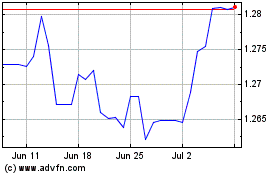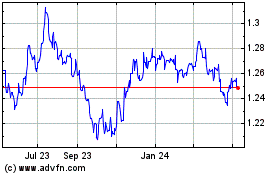Dollar Weakens After In-line U.S. GDP Data
July 28 2017 - 5:20AM
RTTF2
The U.S. dollar fell against its key counterparts in the
European session on Friday, as the nation's economic activity
increased in line with economist estimates in the second
quarter.
Data from the Commerce Department showed that the real gross
domestic product climbed by 2.6 percent in the second quarter after
rising by a downwardly revised 1.2 percent in the first
quarter.
Economists had expected GDP to increase by 2.6 percent in the
second quarter compared to the 1.4 percent growth that had been
reported for the previous quarter.
Concerns about the latest developments in Washington also
weighed on the currency after Republican efforts to repeal and
replace Obamacare failed in Senate again.
The so-called "skinny repeal" failed by a vote of 49 to 51, with
three Republican Senators joining with Democrats to stop the
bill.
Investors look forward to the University of Michigan's revised
report on consumer sentiment in July, due at 10:am ET. The index is
expected to be unrevised from the preliminary reading of 93.1.
The greenback fell against its major counterparts in the Asian
session, with the exception of the franc.
The greenback dropped to 0.9645 against the Swiss franc,
following more than a 4-week high of 0.9727 hit at 7:30 am ET. The
next likely support for the greenback-franc pair is seen around the
0.95 region.
The greenback edged down to 110.84 against the Japanese yen,
after having advanced to 111.33 at 5:45 pm ET. The greenback is
seen finding support around the 109.00 level.
Data from the Ministry of Internal Affairs and Communications
showed that Japan's overall nationwide consumer prices rose 0.4
percent on year in June - in line with expectations and unchanged
from the previous month.
Nationwide core CPI, which excludes food prices, also gained 0.4
percent on year - again unchanged and as expected.
The greenback reached as low as 1.1753 against the euro, which
is near a 2-1/2-year low of 1.1777 set on Thursday. The greenback
is poised to challenge support around the 1.19 area.
Preliminary data from Destatis showed that German inflation
accelerated unexpectedly to a 3-month high in July on energy
prices.
Inflation, based on consumer prices, grew 1.7 percent annually,
slightly faster than the 1.6 percent rise posted in June. Inflation
was forecast to ease to 1.5 percent.
The greenback that ended Thursday's trading at 1.3062 against
the pound edged down to 1.3118. Continuation of the greenback's
downtrend may see it challenging support around the 1.33
region.
The greenback weakened to 1.2440 against the loonie, 0.7502
against the kiwi and 0.7994 against the aussie, off its early high
of 1.2567, 2-day highs of 0.7460 and 0.7937, respectively. If the
greenback extends decline, 1.22, 0.76 and 0.81 are likely seen as
its next support levels against the loonie, the kiwi and the
aussie, respectively.
At 1:20 pm ET, Federal Reserve Bank of Minneapolis President
Neel Kashkari is expected to speak at a town hall event, in
Minnesota.
Sterling vs US Dollar (FX:GBPUSD)
Forex Chart
From Mar 2024 to Apr 2024

Sterling vs US Dollar (FX:GBPUSD)
Forex Chart
From Apr 2023 to Apr 2024
